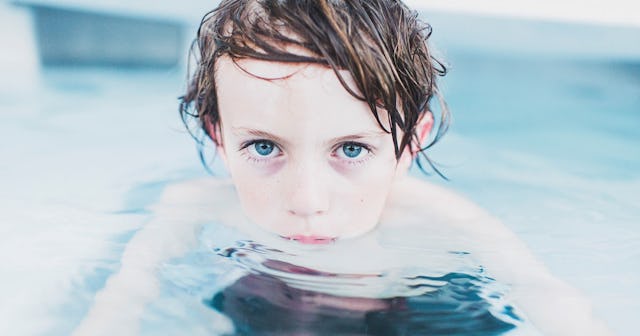What Parents Need To Know About Dry Drowning And Secondary Drowning

When most of us think of drowning, we think of a child submerged or partially submerged in water. And although drowning doesn’t usually look like the “kicking and screaming” image we’ve been fed since we were kids (most instances of drowning are eerily silent), it is usually something that happens pretty instantly.
Drowning deaths — which are the leading cause of death among kids aged 1-4, after birth defects — can happen in a matter of seconds, which is why they are so serious, and why water safety is should be a top priority for parents at all times.
But what you may not know is that not all instances of drowning happen right away. Sometimes your child may go under water or unintentionally swallow water while swimming, and then only experience symptoms of drowning hours or days later. And yes, sometimes these symptoms – especially if not addressed right away – can lead to fatalities.
It’s scary AF, a parent’s worst nightmare, but the good news is that if identified early enough, in most cases, children can get proper treatment, and end up just fine.
Hao Sun/Unsplash
You’ve probably heard of these types of incidents referred to as “dry drowning” or “secondary drowning,” but if you are like most parents, you’ve probably been confused about what those terms mean, and most importantly, what you as a parent can do about it all.
So here’s the low-down. Both “dry drowning” and “secondary drowning” refer to instances of drowning that don’t happen instantly. In both cases, your child will likely have had some sort of experience where they were underwater for some period of time, either in a bath or a pool of water.
Keep in mind, too, that these sorts of things can happen without full or even partial immersion. All that has to happen is that your child has to swallow water into their lungs.
In fact, mom and blogger Holly Loftin penned a piece for Scary Mommy about her son’s experience of secondary drowning after being knocked over by a wave at the beach. Thankfully, after a prompt visit to the ER, he ended up being fine, but it was a terrifying moment when Loftin realized that her son was quickly becoming very ill and unresponsive after he had seemed just fine only moments prior.
Mariano Nocetti/Unsplash
“How could this possibly happen to him? He had barely swallowed any water,” Loftin wrote. “He was absolutely fine all day and had become severely ill in less than an hour.”
OK, so both secondary drowning and dry drowning involve a “delayed drowning” reaction. But what are the distinguishing characteristics of each type?
According to The Cleveland Clinic, in dry drowning, water actually never reaches the lungs, hence the “dry” aspect of it. What happens is that your larynx (voice box) closes up in reaction to excess water being taken into the body. It’s called a laryngospasm, and is very serious, because children are deprived of oxygen while it’s happening.
“In a normal drowning, a swimmer will aspirate a lot of water into their lungs as they struggle in the water,” says Dr. Purva Grover, Medical Director of Cleveland Clinic’s Children’s Pediatric Emergency Departments. “In an atypical drowning, the larynx goes shut as a protective response. No water gets in, but no air gets in either.”
Secondary drowning, on the other hand, involves water aspirated into the lungs, and resembles typical drowning, but with a delayed response. When water collects in the lungs it’s called a “pulmonary edema” which can cause rapid, strained breathing.
As WebMD explains it, signs of secondary and dry drowning can happen within an hour after the occurrence, but sometimes symptoms don’t emerge until 24 hours later. Any concerning symptoms that emerge within the following hours or days after a suspected dry drowning or secondary drowning incident requires a prompt doctor or ER visit. Here are some of the symptoms you might see, according to WebMD:
– Coughing
– Rapid, stressed breathing
– Extreme fatigue or disorientation
– Chest pain
– Irritability
– Change in behavior
– Decrease in energy levels
This is so scary, right? I know as a parent reading about things like this – things that are so unpredictable and sudden – is enough to make me feel totally panicky. The thing is that as scary as this all is, delayed drowning episodes like dry drowning and secondary drowning are relatively rare, and only comprise 1-2% of all drowning cases, as WebMD points out.
Still, it’s so important that parents are aware of these things, because they do happen, and the best way to prevent a tragedy from occurring is to know the signs and rush your kid to the ER if they show any of them.
“[E]very child who has fallen into the water or experienced a near-drowning should be taken to the emergency room immediately,” Dr. Grover commented. “If we can intervene quickly, it’s possible for a child to recover.”
Belanegara “Abe” Abimanyu/Reshot
It’s also super important to take preventative steps so that drowning doesn’t happen in the first place. Here are some things to keep in mind:
– Kids need to be actively supervised (no cell phone, books, or involved conversations) at all times by adults, whether in baths, pools, or oceans.
– Pools should be probably secured against wandering children at all times.
– Properly fitted life jackets are a must.
– Parents should consider a child CPR classes if they haven’t taken one already.
Again, we shouldn’t let these frightening stories prevent us from enjoying the water with our kiddos – all kids should learn how to swim, and enjoy doing so! But that doesn’t mean we shouldn’t be properly educated about how to recognize any potential issues, and what to do if anything goes wrong.